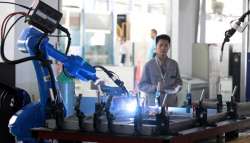Researchers develop new robotic system capable of learning ownership relations, norms
The researchers evaluated the performance of their robotic system in a series of simulated and real-world experiments.

Researchers have developed a robotic system capable of representing, learning and inferring ownership relations and norms that may address some challenges associated with teaching robots social norms and how to conform with them.
According to the researchers from the Yale University, ownership norms are a set of social norms that help to navigate shared environments in ways that are more considerate towards others.
Teaching these norms to robots could enhance their interactions with humans, allowing them to distinguish between un-owned tools and owned tools that are temporarily shared with them, TechXplore reported.
"My research lab focuses on building robots that are easy for people to interact with," co-author Brian Scassellati was quoted as saying by TechXplore.
"Part of that work is looking at how we can teach machines about common social concepts, things that are essential to us as humans but that are not always the topics that attract the most attention," he said.
"Understanding about object ownership, permissions, and customs is one of these topics that hasn't really received much attention but will be critical to the way that machines operate in our homes, schools, and offices," Scassellati added.
In the approach devised by the research team, ownership is represented as a graph of probabilistic relations between objects and their owners.
This is combined with a database of predicate-based norms, which constrain the actions that the robot is allowed to complete using owned objects.
The system devised by the researchers combines a new incremental norm-learning algorithm that is capable of both one-shot learning and induction from examples, with Bayesian inference of ownership relations in response to apparent rule violations and percept-based prediction of an object's likely owners.
Together, these components allow the system to learn ownership norms and relations applicable in a variety of situations.
The researchers evaluated the performance of their robotic system in a series of simulated and real-world experiments.
They found that it could effectively complete object manipulation tasks that required a variety of ownership norms to be followed, with remarkable competency and flexibility.
(With IANS Inputs)